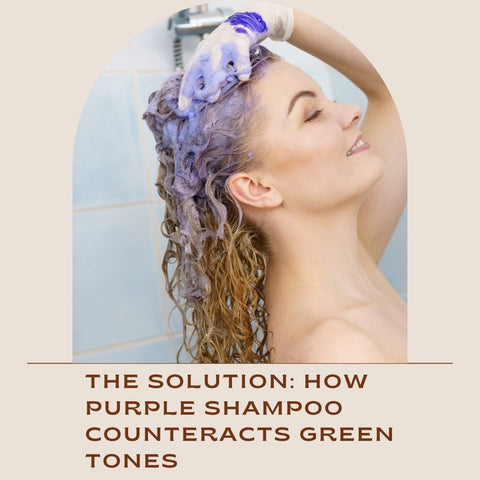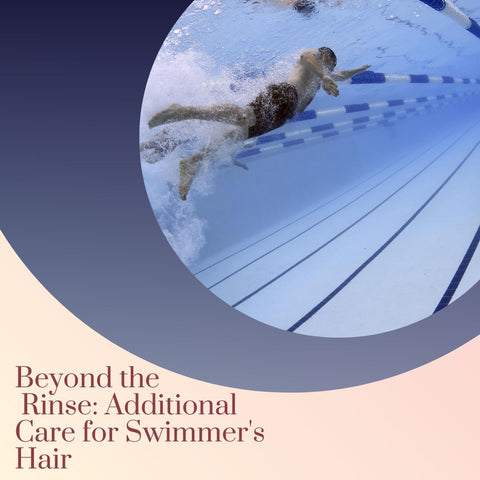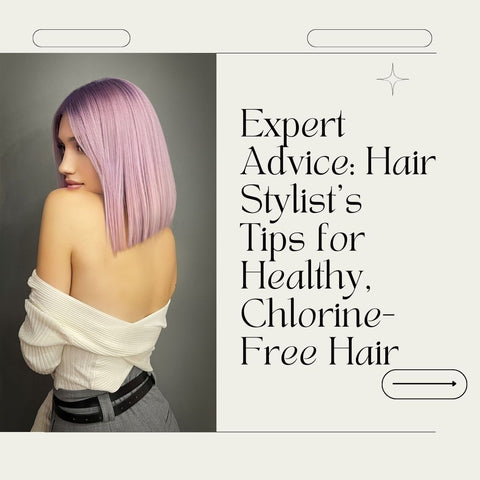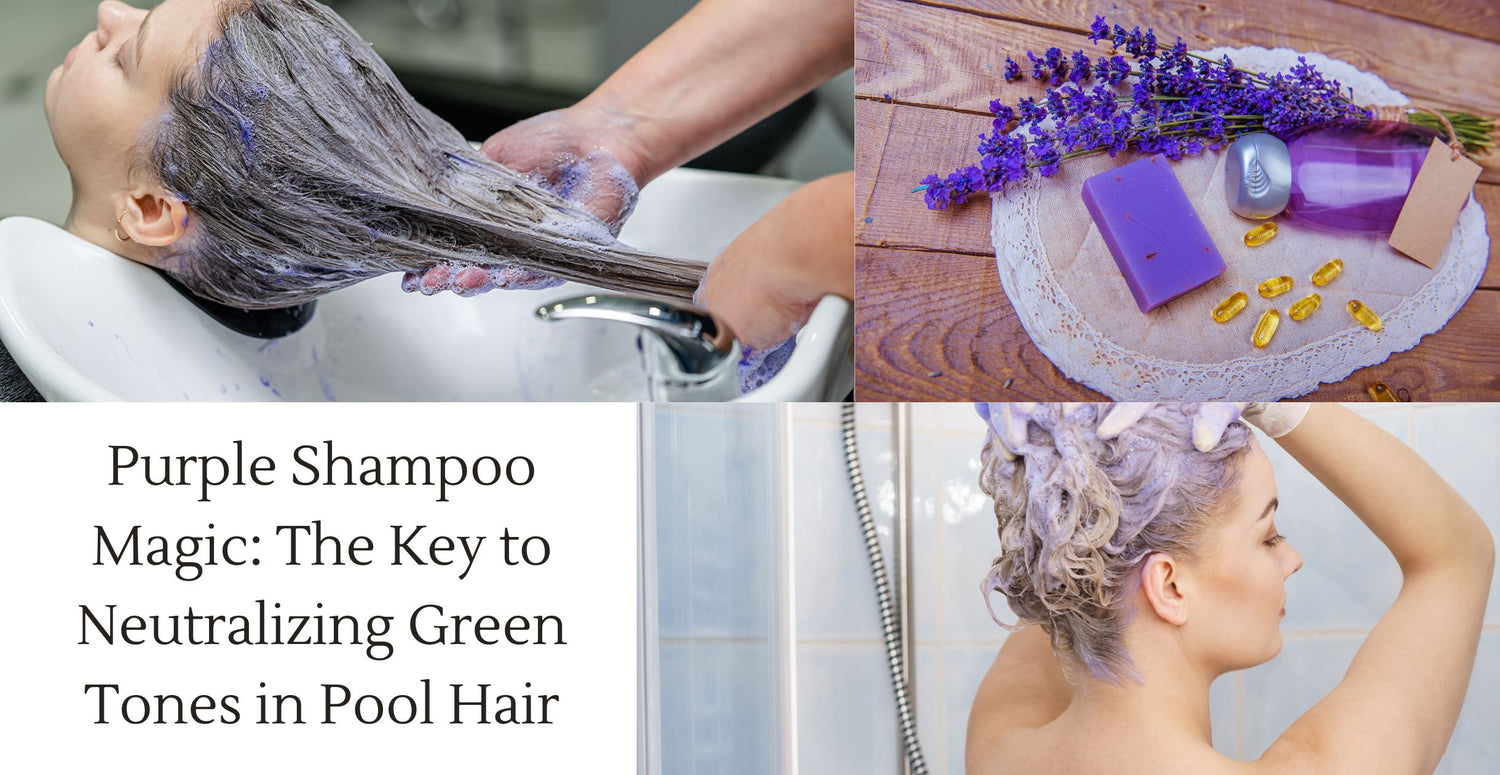Purple shampoo can effectively neutralize green tones in hair, particularly after swimming in chlorinated pools. The shampoo's purple hue counteracts the green on the color wheel, effectively cancelling it out. This is how it works. Chlorine in pool water can oxidize and interact with metals found in hair products or natural oils, resulting in an unwanted greenish tint, particularly in lighter hair colors. Purple shampoo contains purple pigments, which help to neutralize the green tones and restore your hair's natural color.
To use purple shampoo for this purpose, simply apply it to wet hair and concentrate on the areas with the most visible greenish tint. Allow it to sit for a few minutes before rinsing thoroughly. Depending on the severity of the green tint, you may need to repeat this process several times before you get the desired result. Purple shampoo can dry hair if used for an extended period, so it's important to use a moisturizing conditioner afterward. Additionally, using a clarifying shampoo on occasion can aid in the removal of any remaining chlorine buildup.
Diving Into the Problem: Why Pool Water Turns Hair Green

The phenomenon of pool water turning hair green can be perplexing, but it is primarily caused by the interaction of chlorine with certain minerals in the water, specifically copper.
-
Chlorine is frequently used in pools to disinfect the water and kill bacteria. It is effective for pool hygiene, but it may have some hair-related side effects.
-
Copper is sometimes found in pool water due to a variety of factors, including the water source and the pipes used in pool infrastructure. Even trace amounts of copper can react with chlorine to form copper chloride, which can adhere to the hair shaft.
When hair is exposed to chlorinated water with copper, a chemical reaction occurs. The chlorine oxidizes copper, resulting in copper chloride. This compound binds to proteins in the hair, giving it a greenish tint. Lighter hair colors are more susceptible to this effect because the greenish hue stands out more against blonde or light brown hair. Swimmers can enjoy their pool time without having to worry about hair discoloration if they understand the chemistry behind the green tint and take the necessary precautions.
The Chemistry of Chlorine and Hair Interaction
The interaction between chlorine and hair is complex, involving oxidation, protein denaturation, mineral interactions, and pH effects. These processes can weaken the hair structure, change its appearance, and cause problems like dryness, brittleness, and discoloration. Taking steps to protect the hair from chlorine exposure, such as wearing swim caps, rinsing with fresh water, and applying protective products, can help to reduce these effects and keep the hair healthy and vibrant.
Identifying Susceptible Hair Types for Pool Green
While any hair type can be affected by the green tint from chlorinated pool water, some are more susceptible than others. Here's a list of hair types that are more likely to develop a greenish hue:
-
Lighter hair colors, such as blonde and light brown, are more likely to turn green when exposed to chlorinated water. This is because the greenish tint caused by the interaction of chlorine and copper is more visible on lighter hair shades.
-
Porosity refers to hair's ability to absorb and retain moisture. Hair with high porosity absorbs water and chemicals more easily, making it more susceptible to discoloration from chlorinated water. Overly porous hair may also have damaged cuticles, making it more susceptible to chlorine-related issues.
-
Chemically treated hair, such as dyed or permed hair, is typically more porous and thus more susceptible to chlorine damage. The chemicals used in these treatments can weaken the hair's structure, making it more susceptible to chlorine-induced discoloration and dryness.
-
Hair that has already been damaged by heat styling, over-processing, or environmental factors may be more vulnerable to the effects of chlorine water. Damaged hair typically has a compromised cuticle, allowing chlorine to penetrate more easily, resulting in discoloration and drying.
-
Longer hair has a larger surface area and may be more exposed to chlorinated water, increasing the discoloration risk. Additionally, longer hair may take longer to rinse thoroughly after swimming, allowing chlorine to remain on the hair for an extended period.
While these hair types are more likely to develop a green tint from chlorinated water, it is important to note that this problem can affect anyone, regardless of hair type. Preventive measures, such as wearing swim caps, rinsing with fresh water before and after swimming, and using protective products, can help reduce the risk of discoloration while keeping hair healthy and vibrant.
Preventative Measures to Protect Hair from Pool Chemicals
Protecting your hair from pool chemicals such as chlorine is critical for maintaining its health and appearance. Wet your hair, use a swim cap, apply a protective product, rinse immediately after swimming, use a clarifying shampoo, condition frequently, limit exposure, wear protective hairstyles, and avoid heat styling. By incorporating these preventative measures into your hair care routine, you can protect your hair from the harmful effects of pool chemicals while also keeping it healthy, vibrant, and beautiful.
The Solution: How Purple Shampoo Counteracts Green Tones

Purple shampoo works as a solution to counteract green tones in hair due to color theory principles and the interaction of certain pigments. This is how it works.
-
Color theory describes how colors interact with one another. Purple is the opposite of green on the color wheel. This means that purple and green are complementary colors that, when combined, neutralize or cancel each other out.
-
Purple shampoo contains violet or purple pigments that are designed to balance yellow or brassy tones in blonde or light-colored hair. These pigments work by transferring a small amount of purple color to the hair shaft, which helps to counteract any unwanted yellow or brassy tones.
-
When hair develops a greenish tint due to chlorine or other environmental factors, the purple pigments in the shampoo can effectively neutralize the green tones. The purple color cancels out the green, restoring the hair's natural and balanced color.
-
To use purple shampoo to counteract green tones, apply it to wet hair and thoroughly massage it in, focusing on the areas with the most noticeable greenish tint. Before rinsing out the shampoo, let it sit for a few minutes to let the purple pigments work their magic.
-
Depending on the severity of the green tint, it may take several washes with purple shampoo to completely remove the undesirable tones. To achieve the best results, use purple shampoo with patience and consistency.
Understanding Color Theory: Purple Shampoo’s Neutralizing Power
Color theory helps explain why purple shampoo is effective at neutralizing unwanted tones in hair, such as yellow, brassiness, and even green. Purple shampoo's neutralizing properties are based on color theory principles and pigment selective absorption. Understanding how complementary colors interact allows us to see why purple shampoo is such an effective tool for maintaining beautiful and vibrant hair color.
Selecting the Right Purple Shampoo for Your Hair Type
Choosing the right purple shampoo for your hair type is critical for achieving the best results while maintaining the health and integrity of your locks. Here are some factors to consider when choosing a purple shampoo.
-
Hair Colour: Consider the tones you wish to neutralize and the color of your hair. For different tones of grey, silver, or blonde hair, different purple shampoo formulations may be available. While some purple shampoos are gentler and more appropriate for darker blonde or light brown hair, others are more intense and might be better suited for lighter hair colors.
-
Hair Texture: Consider the condition and texture of your hair. Look for a purple shampoo that is made with nourishing and moisturizing ingredients to help hydrate and repair your hair while neutralizing unwanted tones if you have dry or damaged hair. Choose a lightweight formula that cleanses hair without making it feel greasy.
-
Sensitivity: If you have a sensitive scalp or skin, opt for a purple shampoo that is free of harsh chemicals, sulfates, and parabens. Look for gentle, hypoallergenic formulas that are suitable for daily use without causing irritation or dryness.
-
Intensity: Consider the intensity of the shampoo's purple pigments. Some purple shampoos contain a higher concentration of purple pigments, while others are diluted. If you have very light or platinum blonde hair, you may require a stronger purple shampoo to effectively neutralize yellow or brassy tones. However, if your hair is darker blonde or light brown, a milder formula may suffice.
-
Use Frequency: Consider how frequently you want to use the purple shampoo. Select a formula that will not strip or dry out your hair and is gentle enough for frequent use if you plan to use it daily or multiple times per week. If you only plan to use it occasionally for toning or maintenance, you may opt for a more potent formula that delivers quicker results.
-
Additional Benefits: Look for purple shampoos that provide other benefits besides toning, such as hydration, shine enhancement, or heat protection. Consider your hair's needs and select a shampoo that addresses them while also neutralizing unwanted tones.
By taking these factors into account and choosing a purple shampoo that is specific to your hair type and needs, you can effectively neutralize unwanted tones while keeping your hair healthy, vibrant, and beautiful.
Application Tips for Maximum Effectiveness Against Green Tones
To increase the effectiveness of purple shampoo against green tones in your hair, use these application tips:
-
Start with Wet Hair: Make sure your hair is completely wet before applying the purple shampoo. Wet hair makes it easier for the shampoo to distribute and penetrate the hair shaft.
-
Use the Right Amount: Pour a suitable amount of purple shampoo into your hand. Begin with a small amount and gradually increase as necessary, depending on the length and thickness of your hair.
-
Concentrate on Problem Areas: Apply purple shampoo to the areas of your hair with the most noticeable green tones. If the green tint is more concentrated at the ends of your hair, apply the shampoo there. If it is more evenly distributed, run the shampoo through your hair.
-
Complete Massage: Use light, circular strokes to massage the purple shampoo into your hair and scalp thoroughly. Make sure to lather the shampoo thoroughly and distribute it evenly throughout your hair to ensure that all strands are coated.
-
Leave it On: To maximize the toning effect, leave the purple shampoo on your hair for a few minutes. The longer you leave it on, the more time the purple pigments have to balance out the green tones. However, avoid leaving it on for too long, as prolonged exposure may result in over-toning or dryness.
-
Rinse Well: After allowing the shampoo to sit for a few minutes, thoroughly rinse it from your hair with lukewarm water. To avoid a residual purple tint, make sure to remove all traces of shampoo.
-
Follow with Conditioner: After rinsing out the purple shampoo, apply a moisturizing conditioner to replenish hydration and nourishment. This helps to counteract any possible drying effects of the shampoo.
-
Adjust Frequency: Depending on the severity of the green tones and how your hair reacts to the shampoo, adjust the frequency of use. Begin by using the purple shampoo once or twice a week, increasing or decreasing as necessary to achieve the desired results without over-toning.
By following these application tips, you can effectively use purple shampoo to neutralize green tones in your hair while maintaining a vibrant, balanced color.
Beyond the Rinse: Additional Care for Swimmer's Hair

In addition to using purple shampoo to counteract green tones, there are several other steps you can take to keep your hair looking healthy and vibrant after swimming. Here are some tips specifically designed for swimmer's hair:
-
Before entering the pool, apply a protective oil or conditioner to your hair. This forms a barrier that keeps chlorine and other pool chemicals from penetrating the hair shaft and causing damage.
-
After swimming, immediately rinse your hair with fresh water to remove chlorine and saltwater residue. To reduce chemical exposure, thoroughly rinse any residual pool water from your hair.
-
Use clarifying shampoo regularly to remove chlorine, salt, and other impurities from your hair. Clarifying shampoos are designed to deep-clean the hair and scalp, removing buildup while preserving natural oils.
-
Following each wash, apply a moisturizing conditioner to replenish hydration and nourishment to your hair. Look for conditioners that include ingredients like coconut oil, shea butter, or argan oil to help restore moisture and repair damage.
-
Incorporate weekly or biweekly deep conditioning treatments into your hair care routine to provide additional nourishment and repair to your hair. Choose treatments designed specifically for dry or damaged hair to help restore strength and elasticity.
-
Wearing protective hairstyles like braids, buns, or ponytails while swimming can help reduce chlorine exposure tangling, and breakage. Secure your hair away from your face to keep it from absorbing pool water.
-
Limit your use of heat-styling tools like blow dryers, flat irons, and curling irons, as chlorine-damaged hair is more vulnerable to heat damage. When possible, air-dry your hair and use heat-protectant products when you need to style it.
-
Schedule trims every 6-8 weeks to remove split ends and prevent further damage. Trimming your hair regularly helps to keep it healthy and looking good, especially if you swim frequently.
-
Use leave-in conditioners, serums, or sprays designed specifically for swimmer's hair to provide additional protection and hydration. These products can protect your hair from chlorine and UV rays while still keeping it soft and manageable.
Deep Conditioning Treatments for Chlorine-Damaged Hair
Deep conditioning treatments are critical for restoring moisture, repairing damage, and boosting the overall health of chlorine-damaged hair. Here are some deep conditioning treatments designed specifically for hair that has been exposed to chlorine:
-
Treatment with Coconut Oil: Coconut oil is a great deep conditioning treatment for hair damaged by chlorine because of its nourishing and moisturizing qualities. Wet your hair and massage warm coconut oil into the lengths and ends of your hair. After leaving it on for at least half an hour—or overnight for a deeper penetration—shampoo and condition as normal.
-
Avocado and Honey Mask: Honey is a natural humectant that draws and holds moisture, and avocado is high in vitamins and essential fatty acids that help nourish and repair damaged hair. To make a smooth paste, mash a ripe avocado and combine it with honey. Concentrating on the ends of your damp, clean hair, apply the mask. After 30 minutes, leave it on and give it a thorough rinse with lukewarm water.
-
Mayonnaise Treatment: The oils and proteins in mayonnaise can help strengthen and replenish moisture-damaged hair. Load damp hair with mayonnaise, paying special attention to the ends and lengths. Before shampooing and conditioning as usual, cover your hair with a shower cap or plastic wrap and leave it on for 30 to 60 minutes.
-
Banana and Yoghurt Mask: Packed with vitamins, minerals, and natural oils, bananas help hydrate and fortify hair. Lactic acid, found in yoghurt, aids in moisturizing and exfoliating the scalp. Puree a ripe banana into a smooth paste by blending it with plain yoghurt. Apply the mask to clean, damp hair, focusing on the damaged areas. Leave it on for 30 minutes before rinsing thoroughly with lukewarm water.
-
Egg and Olive Oil Treatment: Eggs are rich in protein and vitamins that help repair and strengthen damaged hair, while olive oil helps moisturize and condition the hair. Whisk together one or two eggs with a tablespoon of olive oil until well combined. Apply the mixture to clean, damp hair, focusing on the lengths and ends. Leave it on for 30 minutes before rinsing with cool water and shampooing as usual.
-
Aloe Vera Gel Treatment: Aloe vera gel is well-known for its soothing and moisturizing properties, making it an ideal treatment for dry, damaged hair. Apply pure aloe vera gel to clean, damp hair, concentrating on any damaged areas. After 30 minutes, rinse thoroughly with lukewarm water.
-
Commercial Deep Conditioning Masks: Look for deep conditioning masks that are specifically designed for chlorine-damaged hair. These masks frequently include keratin, amino acids, and botanical extracts, which help repair and strengthen the hair while providing intense hydration.
Natural Remedies vs. Salon Treatments for Green Hair
When it comes to treating green hair caused by chlorine exposure, you can use natural remedies at home or visit a professional salon. Here's a comparison of the two approaches:
Natural Remedies:
-
Natural remedies typically use readily available and affordable ingredients, making them an inexpensive option for treating green hair at home.
-
You can easily make natural remedies with ingredients from your kitchen or pantry, eliminating the need to buy specialized products or schedule salon appointments.
-
Many natural remedies are gentle on the hair and scalp, allowing for regular use without excessive dryness or irritation.
-
While natural remedies can help reduce the appearance of green hair, they may not be as effective as salon treatments, particularly in more severe cases of discoloration.
-
Some natural remedies, such as coconut oil or mayonnaise treatments, necessitate extended application times and multiple washes to produce noticeable results, which can be time-consuming.
Salon Treatments:
-
Professionals with training who have dealt with a range of hair problems, including green hair from chlorine exposure, administer salon treatments.
-
Salons frequently use specialized products and treatments designed to neutralize green tones and restore the hair's natural color.
-
Salon treatments are typically more efficient and effective at removing green discoloration from the hair because they frequently use professional-grade products and techniques.
-
Salon treatments can produce immediate results, with noticeable improvements in hair color and texture after only one session.
-
Salon treatments may be more expensive than natural remedies, particularly if multiple sessions are required to achieve the desired results.
The decision between natural remedies and salon treatments for treating green hair is based on your budget, time constraints, and the severity of the discoloration. If you need a quick and effective solution, salon treatments may be the best option. However, if you prefer a more cost-effective and DIY approach, natural remedies may be a viable option.
Routine Hair Care Tips for Regular Swimmers
Regular swimmers may find it difficult to keep their hair healthy due to frequent exposure to chlorine and other pool chemicals. To keep your hair healthy and vibrant, use pre-swim protection, a swim cap, rinse immediately after swimming, a clarifying shampoo, moisturize with conditioner, deep conditioning treatments, protective hairstyles, limit heat styling, trim your hair regularly, and use protective products. By incorporating these routine hair care tips into your swimming routine, you can help minimize damage, maintain healthy hair, and keep it looking its best even after frequent exposure to chlorine and other pool chemicals.
Expert Advice: Hair Stylist’s Tips for Healthy, Chlorine-Free Hair

As a hair stylist, here are some expert tips for maintaining healthy, chlorine-free hair: pre-swim preparation, use of a swim cap, immediate rinse after swimming, use of a clarifying shampoo, moisturizing with conditioner, deep conditioning treatments, protective hairstyles, limited heat styling, regular trims, and protective products. Following these expert tips will help you maintain healthy, chlorine-free hair and keep it looking its best even after regular exposure to chlorine and other pool chemicals.















